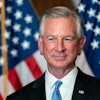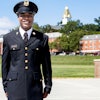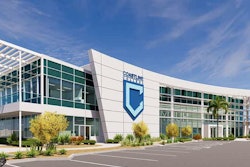With representation on 49 campuses, PAVE (Peer Advisors for Veteran Education) is making an impact as military veterans join the ranks of college students. Dr. Michelle Kees
Dr. Michelle Kees
The support program for incoming military veteran students was founded in 2012 at the University of Michigan (UM). It has three pillars: outreach, support, and linkage to resources. New students are paired with trained peer advisors who help them navigate higher education — from understanding their Veterans Affairs (VA) benefits to seeking out tutoring to connecting them with resources for physical and mental health to finding stable housing.
“The model allows for us to train campus teams on how to provide peer support, how to help engage student veterans on campus, strategies for outreach and connection and an approach for linking student veterans to needed resources,” says Dr. Michelle Kees, director of PAVE and M-SPAN (Military Support Programs and Networks) at UM. “Our job involves offering these teams technical assistance, problem-solving, support, brainstorming around how to best engage student veterans and support them.”
Increasing access for veterans on campus
Incoming veteran students have immediate access to PAVE on the 49 campuses where it currently is available. New students are matched with a peer advisor on enrollment “to offer support and ensure their transition is smooth,” says Adriana Leal, director of the Military & Veteran Center at University of the Incarnate Word.
“Having another student veteran helps our new students ask questions or voice concerns they may be hesitant to do with offices on campus.” While the majority of participants are veterans, some programs also include reservists, National Guard, ROTC and military/veteran spouses and dependents.
The PAVE central office at the University of Michigan plans to advertise grants that allow for expansion to additional schools and note when the program is accepting applications from additional campuses interested in implementing the program. In the meantime, interested campuses can find information on social media or join one of the periodic webinars hosted by Kees and PAVE program manager Kali Lake.
Alex Ortega, a U.S. Army veteran, is the access and engagement coordinator at the Veterans Resource Center of California State University Fullerton. He assumed the position in August 2019. When the pandemic began and everything shut down, he saw a great need for community and reached out to bring PAVE to campus.
“It was a very dangerous time for many students,” says Ortega. In Fall 2020, PAVE came to campus in a virtual platform.
Most team leaders are paid. At many campuses, the peer advisors are volunteers, but at some campuses, such as Cal State Fullerton, they’re paid through the Veterans Administration work-study program.
 Adriana Leal
Adriana Leal
At the University of Oregon, there are two team leaders, paid through VA work-study, and about 10 peer advisors, all of whom are paid thanks to Maria Kalnbach, coordinator of nontraditional and veteran student engagement and success, who secured several grants to make that possible.
“We have a growing population of [military] dependents on our campus,” says Kalnbach, herself a former military spouse. “Most of our students come from out of town or out of state, so for us it’s really important that we connect them to resources and connect them to the community. Here in Eugene and in Lane County we have a lot of veteran resources, and we’re making sure those students know about those resources. We have our Vet Welcome, which is an orientation for veterans.”
Right-sizing programming
Peers can be key in addressing mental health and wellness. Kees is a psychologist in the Department of Psychiatry at the University of Michigan who has been involved with PAVE since its inception, including the early design and implementation. She oversees the research and evaluation of the program.
Ortega is a certified peer support specialist. He is currently an adjunct instructor at Loyola Marymount University teaching a veteran peer-to-peer course, so he clearly understands PAVE’s principles. “There are plenty of resources, especially in this part of the nation, for veterans but navigating it and overcoming the bureaucracy of some of these resources is at the forefront,” Ortega says.
When Ortega matches new PAVE participants with peer advisors, he asks if they prefer someone of the same gender or military branch, but often finds veterans readily identify with other veterans, regardless of background. “There are a lot of events we do that are recreational therapy,” says Ortega. “Recently, I did a recreational paint therapy session. Veterans were able to come in and paint their feelings and emotions on an affirmation painting. We’re creating programming that’s student led and building camaraderie.”
Now that in-person events are possible at Oregon, Kalnbach and the PAVE team are trying to provide more social events and workshops. Forty-four percent of the veterans on campus are women, so Kalnbach makes sure there is ample female representation among the peer advisors.
Support system
Some campuses advertise for peer advisors and others may set up a booth at a student union. PAVE is discussed at new student orientation. There are also connections with veteran student groups on campuses. Alex Ortega
Alex Ortega
“Peer advisors are trained through the web-based platform we have that has seven different modules of training,” says Lake. “They watch a video on each of those modules and then there are a couple of questions at the end to help reinforce that material.”
Each campus is also encouraged to create additional training materials and bring in resources specific to their campus needs and culture. Team leaders are identified and attend national training that PAVE’s national team at Michigan hosts, which has been virtual the last couple of years.
“That training is about how to implement the program, how to be a source of support and how to advocate for student veterans,” says Lake, who is a military veteran. “Sometimes we even see the student veterans who have been served in the program become peer advisors and then team leaders. That’s a really beautiful way to show the effectiveness of the program and the community building it creates.”
Army veteran Mia McCall is the PAVE co-team leader at Oregon. There was a point when she first started as a student that she needed help but hesitated to ask. Eventually, she found her way to PAVE. The sense of community fueled her and she wanted to give back the support she received, so she became a peer advisor. Now a team leader, she provides support to the peer advisors. She is often the first point of contact for incoming student veterans. Topics include health, food security, housing, and education benefits.
Impact of current events
As the conflict rages on in Ukraine, reservists and even veterans are feeling stressed. Kees says over the 10 years of the program she’s seen National Guard and reservist students deployed in the middle of a semester. While it’s not as likely with veterans, it isn’t impossible.
Leal says whenever these types of issues arise, the PAVE team steps up their outreach and check-in efforts. Counselors are available on campus. They will also work with anyone being deployed to see that they don’t lose their benefits or credits.
“Some of the feedback I got from my students is the idea of getting called back … creates a bit of uneasy tension feeling, especially for those who are recently [retired,]” says Ortega. “One student said when she sees [Ukrainian] soldiers hugging or kissing their loved ones before they go into battle, it’s very reminiscent of what they endured before they deployed to Iraq.”
Kalnbach says there is some anxiety as a number of veterans are part of the ready reserves, individuals who can be reactivated after leaving the military. She’s making sure people are aware of the mental health services available on campus and through the federal Department of Veterans Affairs which can help veterans cope with the additional stress. Kalnbach also says that there are considerable mental health resources available for veterans in the state. McCall says the University of Oregon is providing support not only to student veterans, but also to the whole student body by having experts on Russia and Ukraine speak about the subject.
“A lot of the student veteran community is on edge and feels uneasy,” McCall says. “I fortunately am not one of the ones that is on the readiness list, but I know multiple people that are. We are able to provide some of the support, such as what is going to happen with their education benefits. We have a pretty detailed explanation of what can happen and what we can do to make sure those benefits are not going to suffer if they do get called to duty.”
This article originally appeared in the April 14, 2022 edition of Diverse.


















